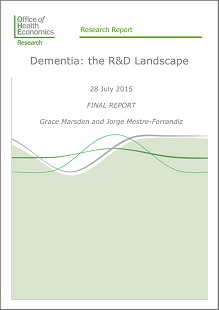This OHE Research Paper provides an overview of the current dementia R&D landscape. The research was undertaken by OHE for Imperial College and the UK Department of Health.
This OHE Research Paper provides an overview of the current dementia R&D landscape. The research was undertaken by OHE for Imperial College and the UK Department of Health.
This OHE Research Paper provides an overview of the current dementia R&D landscape. The research was undertaken by OHE for Imperial College and the UK Department of Health.
The research is intended to provide a factual report of the current R&D landscape. A discussion of the reasons behind, and the implications of, the difficulties that are highlighted in this report will be published elsewhere*.
The report begins with a brief overview of the current thinking on the reasons for successes and failures of dementia treatments, based on a selective literature review. Key observations include:
- R&D costs are higher for neurology and Alzheimer’s disease (AD) (as well as respiratory and oncology) than other therapy areas
- Higher costs are likely due to lower success rates and longer development times
- Recruitment of trial participants is a key challenge in the area of dementia.
The pipeline analysis identified approximately 900 different products for dementia indications, 197 of which were in “active” development, and 17 of which were marketed. The majority of the products in active development were classified as disease modifying (66%) rather than symptom modifying (31%), but only one of the marketed treatments is classified as disease modifying. Of 217 products that had been discontinued or suspended, the most commonly reported reason for termination was due to negative trial results, insufficient efficacy gains (including projects deemed unsuccessful) or adverse effects.
The comparison with other therapy areas demonstrated that dementia indications have lower success rates than other therapy areas (likelihood of being marketed from phase 1 = 7.27% for dementia, and 15.3% for all therapy areas).
This report has also been published on the World Dementia Council site. Click here to access the accompanying press release.
*OHE is collaborating with CTEG to produce a discussion of the implied knowledge gaps and exploration of the difficulties that are highlighted in this report.
